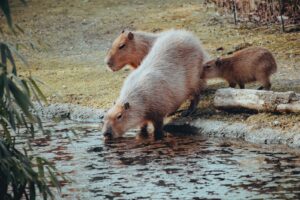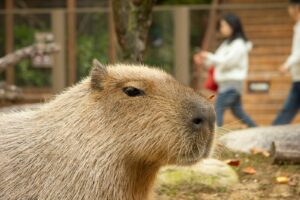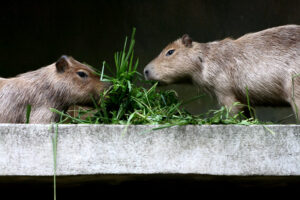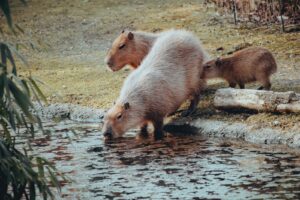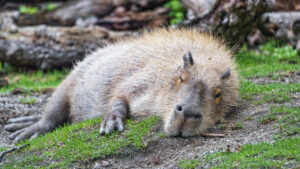With its gentle demeanor and oversized charm, the capybara might not be the first animal you associate with scientific breakthroughs. Yet, these chill giants of the rodent world have unwittingly played a fascinating role in shaping our understanding of ecology, disease transmission, and even social behavior. Let’s delve into the surprising ways capybaras have influenced science.
Capybaras: Living Laboratories for Digestion
Capybaras are herbivores with a unique digestive system. Unlike most mammals, they possess a complex gut microbiome similar to that of ruminants like cows and sheep. Scientists have turned to capybaras as living laboratories to study this fascinating digestive process. By analyzing their gut bacteria, researchers have gained valuable insights into efficient plant digestion, a process crucial for understanding herbivore evolution and resource utilization in ecosystems.
Capybaras: Unveiling the Secrets of Social Behavior
Capybaras are known for their large, social groups. They live in colonies that can number up to 100 individuals, exhibiting complex social interactions. Studying these social structures has shed light on group dynamics, cooperation, and communication within animal societies. Researchers have observed dominance hierarchies, grooming behaviors, and even alarm calls within capybara groups. This knowledge not only helps us understand capybaras but also provides valuable insights into the evolution of social behavior in other mammals, including ourselves.
Capybaras: Unveiling the Zoonotic Disease Connection
Capybaras, due to their abundance and close contact with other animals, can act as reservoirs for various zoonotic diseases – diseases transmissible between animals and humans. Studying the pathogens carried by capybaras helps scientists understand disease transmission patterns and develop strategies for disease prevention. For example, research on capybaras has shed light on the transmission of diseases like Chagas disease and arenaviruses. By understanding how these diseases circulate within capybara populations, scientists can develop better strategies to protect both human and animal health.
Capybaras: Sentinels for Environmental Change
Capybaras are ecologically sensitive creatures. Their populations and behaviors can be impacted by changes in their environment. Studying capybara populations serves as a valuable tool for monitoring environmental health. Fluctuations in capybara numbers can indicate changes in water quality, habitat availability, or even the presence of invasive species. This information empowers scientists and conservationists to take proactive measures to protect not just capybaras but also the delicate ecosystems they inhabit.
The Future of Capybara Science
The scientific exploration of capybaras is far from over. Ongoing research delves deeper into their unique physiology, social behaviors, and role in their ecosystems. We can expect to see further advancements in:
- Understanding their gut microbiome and its contribution to their digestive efficiency
- Unraveling the intricacies of their social communication and cooperation within groups
- Developing more effective strategies for managing zoonotic diseases transmitted by capybaras
- Utilizing capybaras as environmental sentinels to monitor the health of South American ecosystems
Beyond the Science: The Capybara’s Unexpected Appeal
The influence of capybaras extends beyond the scientific realm. Their docile nature and peaceful co-existence with other animals have captured the hearts of people worldwide. The internet is filled with images and videos of capybaras befriending other animals, solidifying their reputation as chill and friendly creatures. This growing fascination with capybaras fosters a sense of connection with the natural world and encourages interest in conservation efforts.
Conclusion: The Unassuming Giant Makes its Mark
The next time you see a picture of a capybara basking in the sun, remember that these seemingly laid-back animals are more than just adorable faces. They are unwitting contributors to scientific progress, environmental monitoring, and even a growing appreciation for the natural world. So, the next time you hear about scientific breakthroughs, keep an open mind – the unlikely hero might just be a giant, friendly rodent.

